|
Theater attendance began to drop off in the early to mid-1980s, when television first became commonplace in Chinese households. As it was possible to present dramatic productions by all existing drama troupes through this medium, fewer and fewer people took the trouble to buy tickets and go to live theater performances. Then came cable and satellite TV, followed by VCDs, DVDs, and the Internet, all of which wrought huge changes on recreational trends. The vast majority of people now prefer to be entertained in the comfort of their homes.
In an effort to revive public interest in live drama, the Drama Research Institute of Beijing University, presided over by well-known theater director Lin Zhaohua, was established formally. At the Theater Forum organized by the institute, notable figures within Chinese performance art circles and foreign dramatists met at the forum to discuss how Chinese drama might be revived as a cultural force in the new millennium.
Drama and Tradition
According to official statistics, China has 2,600 state-run and 3,000 non-state theatrical troupes. Taking into account local operas, there are currently 300 types of drama being performed, yet a large proportion of the Chinese population is unaware of and unfamiliar with its rich performance art heritage, explains Fu Jin, professor at the National Academy of Theatrical Arts, ¡°Since the reorganization of colleges and universities in 1956, drama is no longer a part of the humanities core curriculum, having been incorporated into the more specialized faculty of Chinese classic literature courses. Neither does it feature in primary or high school education.¡± Professor Fu holds that the decline in popularity of Chinese drama is also attributable to theatrical reforms of the 1950s, when opera was the target of socialist transformation, as well as to the influence of Western theatrical concepts since implementation of the reform and opening-up policy in the 1980s. Drama director Lin Zhaohua is both aficionado and advocate of traditional Chinese drama. The aspect of it that most impresses him is its minimalism, whereby the traditional performance skills of singing, gesticulating, elocution and acrobatics, rather than elaborate scenery and settings, convey the plot, background and tone of a play or opera.
Professor Fu Jin is confident that public interest in traditional drama can be revived. To the viewpoint that Chinese tradition is too distant from contemporary life he retorts, ¡°This view does not stand scrutiny. Chinese drama is undeniably dynamic, and in most cases tradition is its source. Peking Opera has a history of more than 200 years, the most admired works being The Fourth Son Visits His Mother created a century ago, and A Bag of Jewels Provides a Story from 60 years ago. New operas have been written, but forgotten after just a few performances.
Says composer Guo Wenjing, ¡°Works of lasting excellence are either those in traditional form performed in a modern spirit, or vice versa. In order successfully to produce an opera in traditional form, its spiritual makings must be transformed. In the 1980s almost all Chinese composers disliked the suona horn (a woodwind instrument), as it was traditionally associated with funerals and weddings. But when I heard the suona played in accompaniment to Chinese rock¡¯ n¡¯ roll singer Cui Jian¡¯s Nothing to My Name, I was electrified. Cui Jian gave the sound of this instrument a totally different character.¡±
Outdated Drama Tuition China introduced the Soviet mode of drama tuition in the 1950s. Since then drama institutes have consisted of directing, performance, stage art, and scriptwriting departments, all dominated by the Stanislavski ¡°method¡± and revolutionary realism. The Central Academy of Drama is Lin Zhaohua¡¯s alma mater, and the education he underwent there now seems to him equivalent to kindergarten. He says, ¡°A drama teacher¡¯s greatest ability lies in his/her ability to emancipate students¡¯ natural gifts, but in the current educational set up there is small likelihood of accomplishing this.¡± In the United States, middle school students watch Shakespeare plays and write critical analyses. Says American drama director Joseph Graves, ¡°Drama has been part of the American university curriculum for a century, and most schools of higher learning offer a BA program in drama.¡± In Chinese history, scholars such as Bai Juyi (772-846), Su Dongpo (1037-1101), and Li Yu (1611-1680) owned family theatrical troupes and did specific research on drama. But in the Chinese academies of drama established in the 1950s, scriptwriting, drama directing and performance are disparate disciplines, which hinders development of student potential. Experts in the field firmly believe that the country¡¯s academic resources are in urgent need of a complete overhaul.
Drama and the Market Dramatist Wei Minglun attributes small theater audiences to stiff competition, since dramas are not like movies and television programs that can be mass-produced by making copies. Professor Fu Jin sees public relations as the key problem. China is a treasure house of excellent works of drama and accomplished performers, but theaters, unlike TV, lack the means and skills to promote and sell themselves to the public. Even so, great efforts are being made to restore and publicize traditional Chinese drama. April 10, 2004 marked the last performance at Beijing University of an updated version of Kunqu Opera Peony Pavilion, written by Taiwanese writer Bai Xianyong. The theater was packed to capacity, and students gave an enthusiastic reception to this 500- year-old opera. A recent lavish production of Kunqu Opera Palace of Eternal Youth was also a great success in Beijing, and plans are afoot to show it abroad. The formal establishment of Beijing University¡¯s Research Institute of Drama occurred upon the institute¡¯s staging of French drama Le Jeu de l¡¯amour et du hazard¡± by Pierre Carlet de Chamblain de Marivaux, directed by Jacques Lassalle, former art superintendent of Comedie-Francaise. The institute is working towards integrating traditional Chinese and modern Western drama in an all-out effort to rejuvenate Chinese live theater and revive its popularity
|
[错误报告] [推荐] [收藏] [打印] [关闭] [返回顶部]

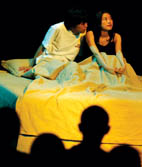 Live Chinese drama is nothing if not dynamic, yet in recent decades its audiences have dwindled. No matter how well produced and performed a play or opera might be, it is unlikely to attract sufficient theatergoers to make it run for more than a few performances. From the Yuan Dynasty (1206-1368) right through to the 1960s, stage drama was the dominant form of entertainment in China. Daily performances were suspended only at times of national mourning upon the death of an emperor, and then for only three days. By the late Qing Dynasty (1644-1911) there existed a repertoire of more than 1,000 Kunqu operas ¨C (awarded the title Masterpieces of the Oral and Intangible Heritage of Humanity by UNESCO in May 2001). This has now shrunk to 100, performed by the six remaining Kunqu Opera troupes in China.
Live Chinese drama is nothing if not dynamic, yet in recent decades its audiences have dwindled. No matter how well produced and performed a play or opera might be, it is unlikely to attract sufficient theatergoers to make it run for more than a few performances. From the Yuan Dynasty (1206-1368) right through to the 1960s, stage drama was the dominant form of entertainment in China. Daily performances were suspended only at times of national mourning upon the death of an emperor, and then for only three days. By the late Qing Dynasty (1644-1911) there existed a repertoire of more than 1,000 Kunqu operas ¨C (awarded the title Masterpieces of the Oral and Intangible Heritage of Humanity by UNESCO in May 2001). This has now shrunk to 100, performed by the six remaining Kunqu Opera troupes in China.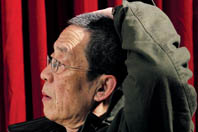
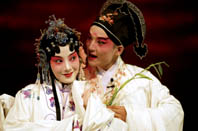
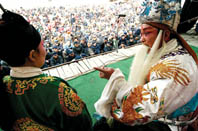
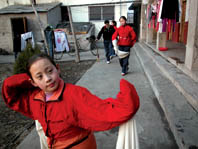
 已有
已有













